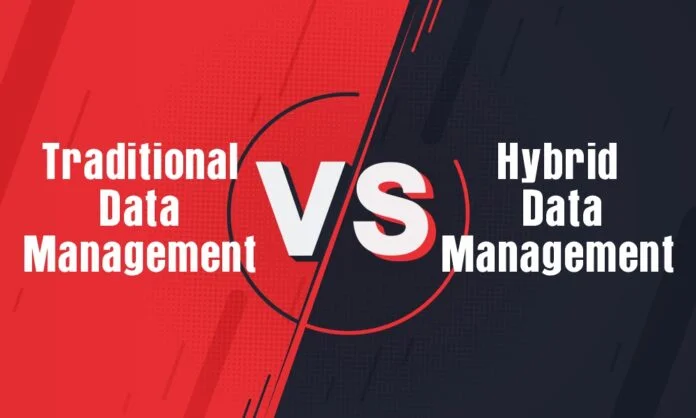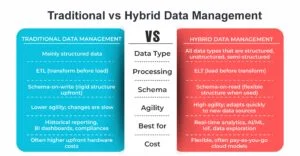Picture your business information as water. For many years, we constructed sturdy, dependable pipes to send this water from one location to another. This was great when the water supply was stable and certain. What happens when it rains from multiple clouds, the flow is a flood, and you have to irrigate various types of gardens at once? This is today’s data management challenge and where traditional vs hybrid data management becomes a key conversation.
For years, companies have had a single, centralized solution for all their data requirements: the classic data warehouse. It was the only game in town for holding and examining structured data, that is, sales numbers, customer information, and financial transactions come to mind. It was and still is an excellent means of obtaining crisp, point-in-time answers to key questions. But the digital universe has exploded. Now information doesn’t only stem from your cash register; it floods in from web clicks, social media streams, IoT sensors, and mobile app interactions. That information tends to be unstructured and enormous in quantity and must be processed at light speed.
This is where the discussion of traditional vs hybrid data management becomes essential. It is not about one being inherently superior to the other. It is about knowing which method, or which blend, is best for your specific business requirements. Let’s explore this step by step.
Understanding the Traditional Data Management
The traditional method is constructed on top of the data warehouse foundation. Imagine it as a huge, well-ordered library. All of the books (data) are labeled carefully, placed on predetermined shelves, and obey a strict set of regulations. Any data that comes into this library is first cleaned, formatted, and organized, a process called ETL (Extract, Transform, Load).
This method is extremely powerful for business intelligence reporting. It offers you a single source of truth that is consistent, trustworthy, and great for complex queries on structured data. Big firms such as Walmart reportedly utilize huge conventional data warehouses to optimize supply chains and inventories with amazing accuracy, processing petabytes of structured sales data.
Yet, its stiffness is also its constraint. ETL takes time. By the time data gets cleaned, converted, and loaded, it may not be “fresh” enough to support real-time decision-making. Plus, it finds it very difficult to deal with the noisy, unstructured data that characterizes today’s digital world.
The Agile Newcomer: Hybrid Data Management
Traditional vs hybrid data management becomes even more relevant when we look at how hybrid systems solve modern challenges. The hybrid data management model recognizes a simple fact: one size will not fit all. Rather than having one library, it builds an entire environment. The environment has the trusted old warehouse to do what it does so well, but it also incorporates other specialized offerings, such as data lakes and cloud services, to manage everything else.
A data lake, a major part of most hybrid models, is similar to a huge natural reservoir. It can hold structured, unstructured, and semi-structured data in its raw, native state. There are terabytes of web log files, social media opinions, and sensor data from machines that can be dumped into the lake directly without prior processing. This enables data scientists to jump in and play with this raw data for sophisticated analytics and machine learning and find things that wouldn’t be possible otherwise.
The real magic of the hybrid method lies in the versatility of its processes. Whereas older systems employ ETL, hybrid solutions tend to employ ELT (Extract, Load, Transform). Data is loaded into the lake first, immediately, and only transformed when required. This allows for real-time or near-real-time availability of data, which is important for applications today.
Netflix is a prime example of a hybrid model in practice. They employ both data lakes and data warehouses. They process structured viewing data to know what we enjoy, yet they handle enormous amounts of unstructured video data in real-time to maximize streaming quality on millions of devices at once. This flexibility and capability would not be achievable if they had a traditional system alone.
Comparison: Traditional vs Hybrid Data Management
Which One Works for Your Business?
So how do you decide between traditional vs hybrid data management? Ask yourself these questions:
What type of data do you work with most? If your business is purely based on clean, structured, internal data (say accounting firms or some part of manufacturing), a classic data management system could be just right and inexpensive.
How quickly do you require insights? If you must make decisions in seconds or minutes on old data, such as fraud detection for banks or personal offers in e-commerce, you require the real-time abilities of a hybrid data management strategy.
Are you developing AI or machine learning? These technologies use huge amounts of different kinds of raw data to work effectively.
Wrapping Up!
For most contemporary enterprises, the solution isn’t a rigid either-or proposition. The future is integration. The most effective approach is a hybrid data management approach that honors the strength and stability of the classic data warehouse for mission-critical reporting but also celebrates the flexibility of data lakes and cloud environments for innovation and real-time analysis. It is creating both a trustworthy and strong pipeline so that it does not matter how your data flows in; you are ready to turn it into growth.
To learn more, visit YourTechDiet!
FAQs
1. How is traditional data management different from modern data management?
Answer: Traditional data management employs fixed systems such as databases to store and report data. Modern data management is more agile, employing cloud, AI, and real-time systems to process large and rapidly changing data.
2. What is hybrid data management?
Answer: Hybrid data management uses both new and old systems, such as coupling reliable databases with innovative cloud-based tools.
3. What is traditional data management?
Answer: Traditional data management is the traditional method of storing and managing data in structured databases for reporting and business data.
Recommended For You:
What is Hybrid Data Management? Why you need it in digital transformation?
Data Management Platform – Analyzing and Managing Customer’s Data


